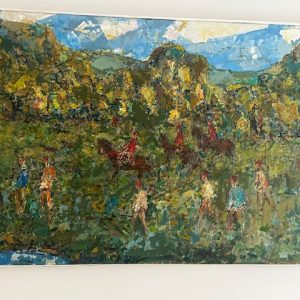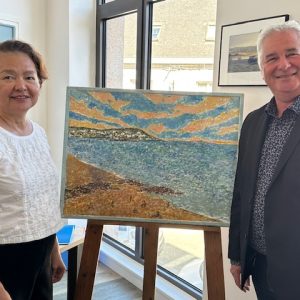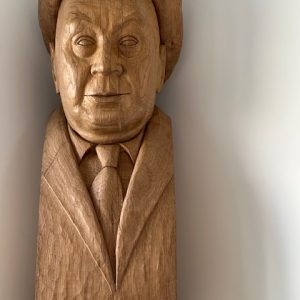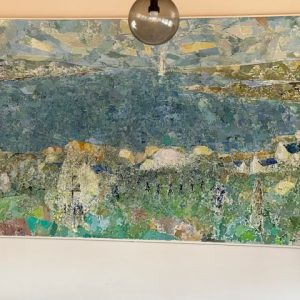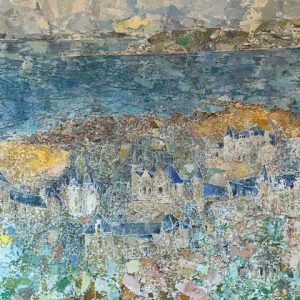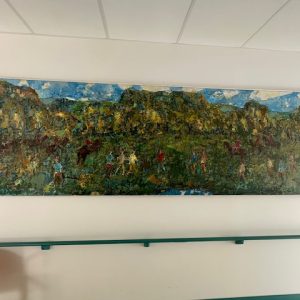Macario Vitalis, a Philippine painter in Brittany
Macario Vitalis, a Philippine artist-painter, spent much of his life in France and especially at Plestin-les-Grèves in Brittany. These past two days, my wife June, the outgoing Philippine Ambassador to France, and I made a visit to Plestin-les-Grèves to discover the rich life and work of Vitalis. We were accompanied by Margo Babilonia Calderero-Le Lain, President at ACCES – Art and Cross-Cultural Exchange Society, and her husband Jean-Claude.
Plestin-les-Grèves is a beautiful little town of almost 4,000 inhabitants, situated on the north coast of Brittany, 525 km west of Paris. It is a commune in the Côtes-d’Armor department of Brittany in north-western France.
What is instantly striking in the centre of town is the beautiful church Saint-Efflam, and the imposing town hall (“Mairie”). And beyond that Plestin-les-Grèves has a beautiful coastline and beaches.
Macario Vitalis (1898-1989) spent much of his life as a painter in France, from the 1920s to the mid-1980s, particularly in Puteaux and then Plestin-les-Grèves. Vitalis appreciated particularly the landscapes and light of the small coastal town.
Vitalis arrived in France in the mid-1920s, after studying at the Fine Arts schools of San Francisco and Philadelphia. His first contact with Brittany took place in 1946, following his participation in a summer camp. He settled there in 1957, until his return to the Philippines where he died in 1989.
Vitalis’ life was not without drama. Having an American passport due to being a citizen of the Commonwealth of the Philippines, he was interned by the Germans from 1941 to 1944 at the Royallieu Camp in Compiègne
We were very warmly received by Christian Jeffroy, the mayor of Plestin-les-Grèves, and his colleagues, who regaled us with memories and stories of the life of Vitalis. The painter settled in Plestin-les-Grèves alone. But he was quickly adopted by the community, inspired by his artistic talent and modest personality.
As Vitalis was a penniless artist, the local community accepted his paintings as recompense for supporting his life. He was even offered a simple, modest shack to live in. The upshot is that the community of Plestin-les-Grèves retains an important collection of his works, which does not seem to be well documented.
Mayor Jeffroy firstly greeted us at the EHPAD Le Gall retirement home, which had three Vitalis paintings, most notably a large, long work of a local horse race. Please see the photos of the paintings.
We then moved to the town hall, which had four Vitalis paintings. The photo of the mayor and June is with an unsigned Vitalis painting which is in the town hall. The mystery behind this painting is still to be discovered.
And lastly, we visited the Public School Kindergarten Macario Vitalis, which has been named in his honour. As Mayor Jeffroy explained, Vitalis is seen as being symbolic of the values that Plestin-les-Grèves would like to transmit to its children – openness to the world, importance of culture, social solidarity, and education (Vitalis gave classes to local students).
The painting style of Vitalis evolved through his life. He was initially inspired by cubism before turning to a style inspired by impressionism and then by pointillism. Some of his works are marked by abstraction.
It is clear that Vitalis left a great mark on Plestin-les-Grèves. And like the case of many expatriates, that mark is perhaps stronger in France than it is in the Philippines.
Mayor Jeffroy and his team were clearly touched by our visit, and offered June the town medal, such that she is now an honorary citizen of Plestin-les-Grèves.
Following these positive contacts, Margo Babilonia Calderero-Le Lain is now exploring possible future cultural and artistic projects. Such projects should aim to raise the profile of Vitalis and Plestin-les-Grèves in the Philippines and in France. This could include developing local trails so that visitors to Plestin-les-Grèves could walk in the footsteps of Vitalis and his art. Needless to say, much work needs to be done fully discover the life of Macario Vitalis.
